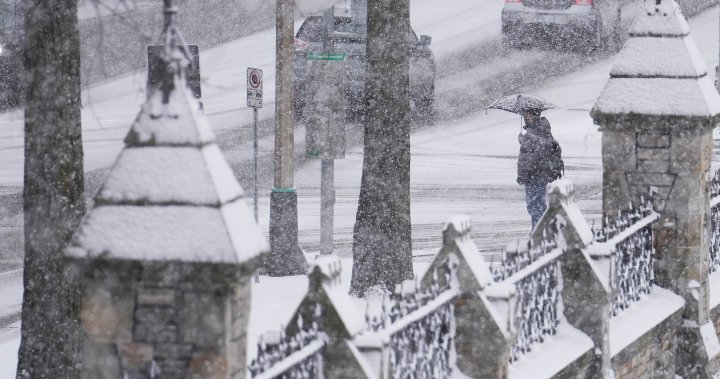A potent blast of Arctic air, originating from a swirling polar vortex over Canada, is poised to disrupt weather patterns across North America, commencing this weekend. This frigid air mass will usher in a period of significantly cold temperatures, particularly impacting Eastern Canada, where some regions are expected to experience the coldest conditions in several years. The initial effects will be felt across the Prairies, with blizzard warnings already issued for Winnipeg, and temperatures plummeting to the -20s Celsius, accompanied by wind chills approaching -40 C or lower in Saskatoon, Regina, and Winnipeg.
This surge of cold Arctic air will progressively advance south and east, trailing a cold front that will initially bring rain or wet snow to southern Ontario and Quebec on Saturday. By Sunday night, the precipitation will transition to snow in the Maritimes. The core of the polar vortex, a large area of low pressure and cold air surrounding both of the Earth’s poles, will be situated over northeastern Canada. However, a lobe of exceptionally frigid air originating from Siberia will be drawn southward on the western flank of this vortex, bringing the coldest daytime high temperatures in two to three years to many cities across Southern Ontario.
Environment Canada has issued advisories, warning Canadians in the affected regions to brace for “very cold” conditions from Sunday through Wednesday. The agency emphasizes the potential severity of the cold, noting that temperatures may be colder than what has been experienced in recent years. They also stress the importance of taking precautions against frostbite, which can develop rapidly on exposed skin in such extreme cold, and advise individuals to stay dry to maintain warmth. The coldest temperatures are anticipated on Monday and Tuesday, followed by a gradual moderation later in the week.
During the peak of this cold snap, daytime high temperatures will remain well below zero, plunging into the double digits below Celsius. Wind chills will exacerbate the cold, potentially reaching as low as -40 to -45 C across northern Ontario and Quebec. Southern portions of these provinces, along with Atlantic Canada, will experience wind chills closer to -30 C. The unusually far-reaching nature of this cold air mass extends its influence deep into the southern United States, posing a significant threat of snow and ice from Texas to the Florida Panhandle. Sub-freezing temperatures could even impact Florida’s citrus crops early next week.
The impact of this Arctic air outbreak will be felt as far south as Washington D.C., where U.S. President-elect Donald Trump’s inauguration on Monday is predicted to be the coldest in 40 years, with wind chills in the minus teens Celsius. Consequently, the inauguration ceremony will be held indoors, a decision not taken since Ronald Reagan’s second inauguration in 1985. While a temporary reprieve from the extreme cold is expected towards the end of next week, long-range computer models suggest a potential return to frigid conditions near the end of January.
This widespread cold snap underscores the significant influence of the polar vortex on North American weather patterns. The southward plunge of Arctic air, facilitated by the dynamics of the polar vortex, can bring extreme cold temperatures far beyond their usual domain. This particular event highlights the importance of preparedness for such extreme weather events, including awareness of the risks of frostbite and hypothermia, and taking necessary precautions to stay warm and safe. While temporary warming is expected, the possibility of a return to frigid conditions later in the month suggests the need for continued vigilance and preparedness throughout the winter season. The impact on agriculture, as seen with the potential threat to Florida’s citrus crops, further underscores the economic consequences associated with such extreme weather events. The unusual southward reach of this cold air mass is a significant meteorological event with far-reaching implications.
The event also serves as a stark reminder of the interconnectedness of global weather patterns. The influx of Siberian air, combined with the dynamics of the polar vortex over North America, demonstrates how atmospheric conditions in one region can significantly influence weather in distant locations. The extreme cold experienced in Canada and the United States is a direct consequence of this complex interplay of atmospheric factors. Understanding these complex dynamics is crucial for predicting and preparing for future extreme weather events. The severity of this cold snap, and its potential for recurrence later in the month, emphasizes the importance of long-term weather forecasting and its role in mitigating the impacts of such events.
The disruption caused by this cold air outbreak extends beyond immediate personal discomfort and potential health risks. The shift to an indoor inauguration ceremony for the U.S. President-elect is a testament to the practical challenges posed by extreme weather. Furthermore, the potential damage to agricultural interests, such as Florida’s citrus crops, highlights the economic ramifications of these events. The widespread impact of this cold snap underscores the importance of robust infrastructure and preparedness measures to minimize disruptions and protect vulnerable populations and industries. The long-range forecasts suggesting a potential return to frigid conditions later in January highlight the need for continued vigilance and preparedness in the face of evolving weather patterns.
The intensity and breadth of this cold snap highlight the ongoing challenges posed by climate variability and the potential for extreme weather events. While this particular event is not directly attributed to climate change, it serves as a reminder of the vulnerability of various sectors, from human health to agriculture and infrastructure, to extreme temperature fluctuations. The need for accurate weather forecasting and effective communication of risks to the public is crucial for mitigating the impacts of such events. The potential for a return to frigid conditions later in the month underscores the importance of continuous monitoring and preparedness for evolving weather patterns.
The impact of this cold snap on various regions of North America underscores the importance of regional preparedness and coordination of resources. From blizzard warnings in the Prairies to potential crop damage in Florida, the diverse impacts require tailored responses based on local conditions and vulnerabilities. The coordination between meteorological agencies like Environment Canada and their counterparts in the United States is essential for providing accurate forecasts and timely warnings to the public. The complexity of this weather event, involving the interplay of a polar vortex and Siberian air, highlights the importance of ongoing research and advancements in meteorological science for improving prediction and preparedness for future events.
The widespread impact of this Arctic air outbreak, from Canada to the southern United States, serves as a compelling example of the power of atmospheric phenomena to disrupt daily life and pose significant challenges. The severity of the cold, its far-reaching impacts, and the potential for its return later in the month emphasize the importance of preparedness, vigilance, and ongoing research to mitigate the effects of extreme weather events. The coordinated efforts of meteorological agencies, government bodies, and individuals are essential for minimizing disruptions and protecting vulnerable populations and industries in the face of such challenges.










